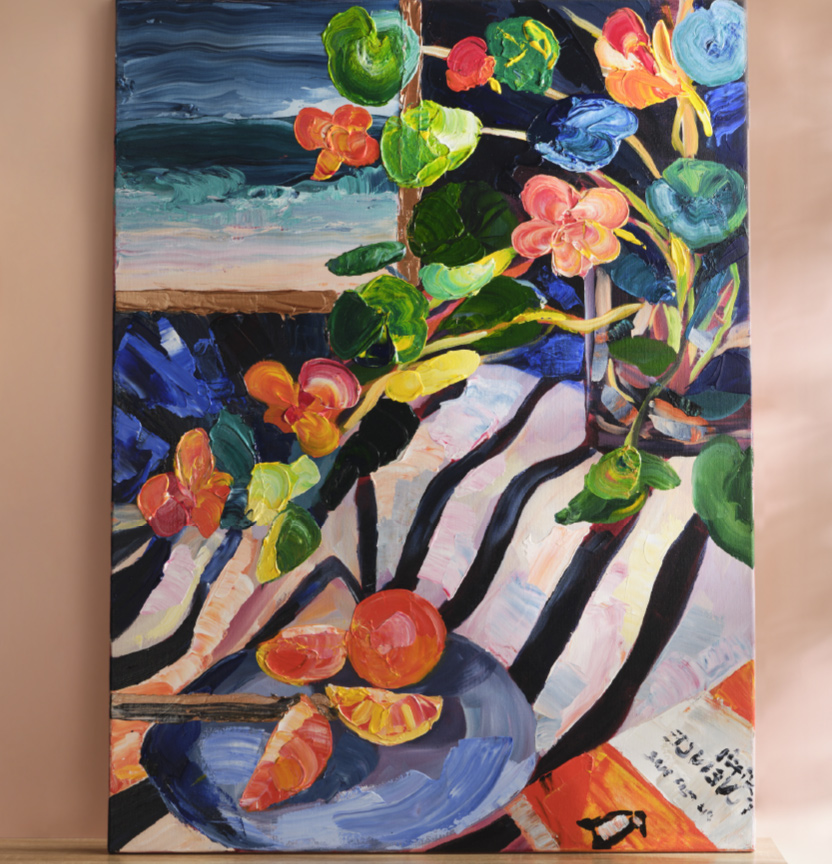 | ||
| Your browser is not supported. | ||
|
Please browse our site using any of the following options:
| ||
SUN DRENCHED SUMMER PAINTING

Level: Advanced
What you'll need:
- Titanium White
- Medium Yellow
- Deep Yellow
- Orange
- Rose Red
- Deep Madder
- Ultramarine
- Prussian Blue Hue
- Viridian
- Payne's Gray
- Bronze
Instructions:
Prepping the Canvas:
Step 1- Draw up main shapes with a pencil. Refer to grid for intersecting points for shape placement.
Step 2- Measure up grid on your chosen surface and then draw the main shapes in using the grid as a guide.
Step 3- Paint entire canvas with a thinned layer of Deep Madder. Allow to dry.
This is a transparent colour, you should still be able to see your pencil guideline drawing through this.
Painting the Summer Drenched Look:
Step 1- Place a thin layer of Deep Yellow where the main warm shapes are (flowers, oranges, stems, book in left corner).
Step 2- Place Prussian Blue thinly over dark areas in the top half of the painting (behind the vase and painting).
Step 3- Place Deep Madder on the dark striped areas of the tablecloth.
Step 4- Using a palette knife use Prussian Blue Hue (mixed with White) and Viridian (mixed with White) to the landscape painting in the right top corner. Apply colours in stripes for the top 2/3rd (the water and sky) and then allow to intersect with the palette knife to create an impressionist coastal landscape.
Step 5- Using a brush or palette knife apply White mixed with a touch of Orange. Also mix a pastel purple with a little of both the Deep Madder and Prussian Blue Hue with White.
Step 6- The plate: Mix Prussian Blue with Deep Madder and White to create a blue/purple. Use this in the shadows. Gradually add more White for the lighter parts of the plate. The front of the plate is pinker - add some Rose Red with Ultramarine and White for a light pinky purple.
Step 7- The light stripes in the tablecloth: Deep Yellow, Rose Red, Prussian Blue, Orange and lots of White! Create pastel tints of each colour listed by using the tiniest bit of colour with White. Now notice where the light hits the "White" stripes. Use your warm mixes (pastel Deep Yellow and Pastel orange). Gradually use the pink (Rose Red and White) and the soft blue to the areas where less light is on the "White" stripes.
Step 8- Apply Orange to the book cover and the oranges and where the flowers are (except over the landscape painting)
Step 9- Give your orange and segments a bit more dimension. Use Deep Yellow, Orange, Orange mixed with Rose Red and White, Orange and White, Deep Yellow and White. Apply with either a palette knife or big brush to create juicy shapes the create form.
Step 10- Add Orange and Deep Yellow to the book. Add White with a bit of Deep Madder and Prussian blue (to make a gentle grey) to the White of the book.
Step 11- Add some stems in with mixes of Deep Madder with White, Orange or Deep Yellow with White.
Step 12- Time to experiment with mixing a range of greens: Medium Yellow & Viridian (bright green), Deep Yellow & a little Viridian (warm olive green), Viridian & a little Deep Yellow (rich green), Prussian Blue Hue & Deep Yellow (Dark Green), Ultramarine & Viridian (teal) and soft pastel add White.
Step 13- Play with applying mixes in different areas for leaves. Think loosely of shapes. Dark ones next to light ones - bounce the colour around. A palette knife or brush swirl when loaded with a few mixes is an interesting way to make painterly leaves. Add broken shapes of leaf and stem in the vase.
Step 14- Nasturtium Flowers: play with mixing coral pinks (Rose Red and Orange plus tint with White), Orange with White, Medium Yellow and Deep Yellow. Playfully add the petals as loose shapes to create the impression of flowers.
Step 15- Dark tablecloth stripes: Apply a layer of Payne's Grey to these. A little White added or ultramarine blue for the "lighter" dark stripes.
Step 16- Bronze for artwork frame. Bronze for Knife (on plate with oranges) with a little Payne's Grey added to shadow areas of the knife.
Step 17- Loosely suggest penguin and title on book on left corner with Payne's Gray and White
Step 18- Apply Paynes Grey and Ultramarine to areas in the background where you think it should be lighter or darker. Allow to dry.
Stand back and check you are happy with your placement of leaves and flowers - there is no right or wrong - but we are wanting to consider colour balance and placement.




